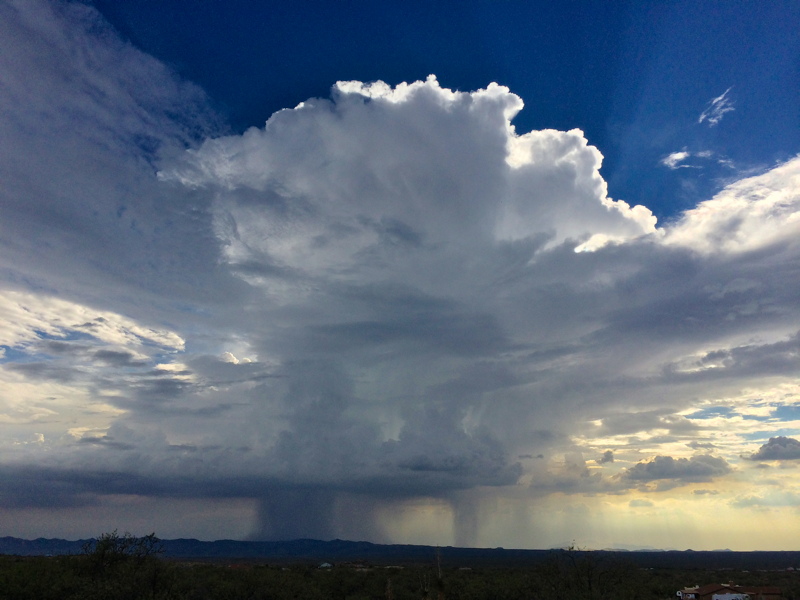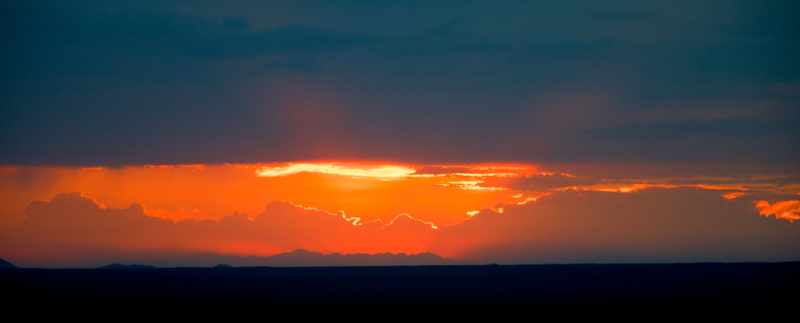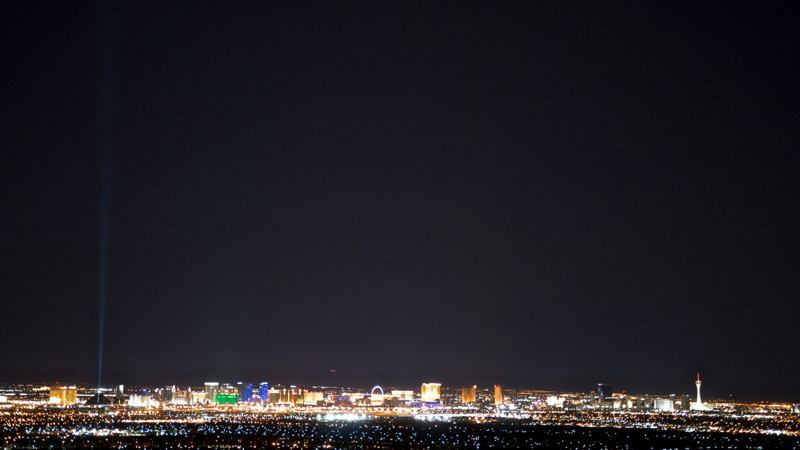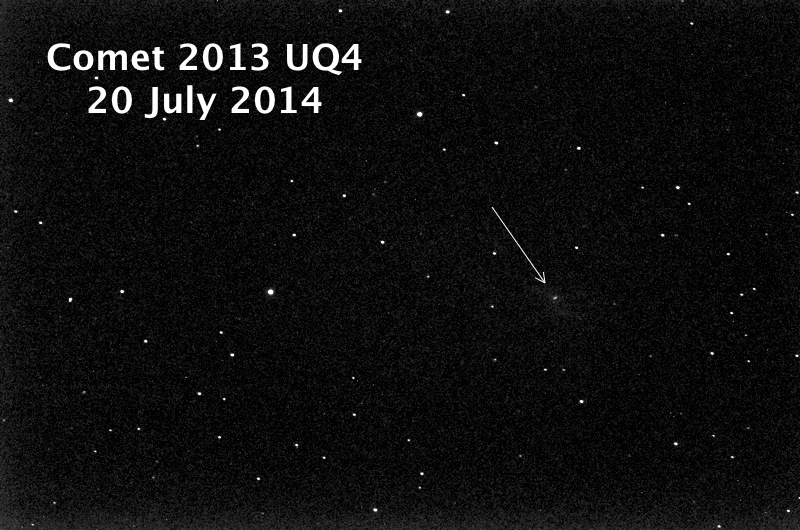
Weather Update, Double Star 61 Cygni, Comet 2013 UQ4
Posted: 21 July 2014
As forecasted, monsoon storms arrived on Thursday, 3 July. Got 0.25" rain from a couple of thunderstorms that day. This thunderstorm was west of the observatory on Saturday, 5 July:

I tweeted the photo; it was picked up by The Weather Channel and received considerable retweeting over the next several hours.
Cloudy skies continued. Needed the rain and still do since very little rain actually fell at the observatory, but the weather did keep me from getting more images of the close conjunction of Ceres and Vesta. Of course, cloudy skies can make for pretty sunsets, like this one from Thursday, 10 July 2014:

Picked up another 0.36" of rain on Sunday, 13 July. Skies remained cloudy.
On Saturday, 19 July, did a quick one-day (and night) trip to Las Vegas to see some friends at their house on a hill in Henderson, Nevada, overlooking Las Vegas. Although the view of the city and surrounding area was very nice, this photo of the Las Vegas "Strip" shows a lot of light pollution:

The sky was partly on our return home. I was tired from the long drive back from Nevada, but with more monsoon storms on the way, I decided to do a short session in the observatory.
|
Opened: Sunday, 20 July 2014, 1929 MST Temperature: 96°F |
Session: 705 Conditions: Partly Cloudy |
1930 MST: sunset. 1940 MST: viewed Mars, 83X. Gibbous phase was visible but no surface details. At 222X, white areas were visible at both polar regions, but no other details were visible. Seeing was not good (thin clouds). 1950 MST: Saturn, 222X. Clouds were hampering the view but the moons Titan and Rhea were visible, as was Cassini Division. 1954 MST: the moons Dione and Tethys became visible.
2000 MST: Powered on the GC Wi-Fi Adapter and used SkySafari Pro on my iPhone 5s to GOTO the double star 61 Cygni. The two bright stars were easily seen using 83X and 222X. According to an article in the August issue of Sky & Telescope magazine (page 50), one of the bright stars is close to a fainter star but the proper motion away from the faint star will be very evident in a one year period. My plan is to image 61 Cygni this year and next year to show the proper motion. Initially, the faint star was not visible due to the still bright sky and some thin clouds. At 2012 MST, the faint star was visible using averted vision at 222X. As the sky darkened the faint star became easier to see. Unfortunately, a thick band of clouds was approaching the constellation of Cygnus. 2027 MST: the faint star was no longer visible. Decided I would have to defer imaging to a later session.
2030 MST: using SkySafari Pro, slewed to Asteroid/Comet 2013 UQ4. It was obscured by thin clouds. While waiting for the clouds to move out of the way, I took advantage of some holes in the clouds to do some binocular sky observing.
In November 2013, I posted my review of the Celestron Cometron 12x70 Binoculars that I had purchased at the Arizona Science and Astronomy Expo. As I noted in the review, I had contacted Celestron Support a few days after the purchase about the eyepieces "teeter-tottering", moving the optics into and out of collimation. At the time, the response was "that's normal". I never really believed that, but decided I could tolerate the problem when it occurred. Over the past few months of use, sometimes the views were excellent and sometimes they were lousy.
At the Oracle State Park "Star Party" on 21 June 2014, I had wanted to use the Cometron 12x70 binoculars on a tripod to show wide angle views of the night sky to Park visitors. However, the movement of the eyepieces was so large and the collimation was so bad that I quickly gave up using the binoculars. The next day I sent a followup message to Celestron, noting the very public problem with their product. I quickly received a followup that stated they would realign or replace the binoculars. A shipping label was provided by Celestron and the binoculars were shipped to them on 27 June. The replacement (covered under the original warranty) was received on 13 July.
An initial daytime test on receipt showed a dramatic improvement in collimation over the one I originally reviewed in November 2013. My quick tests this night showed that the collimation was definitely better, as was coma. Stars only showed some coma when very near the edge of the field-of-view. The diopter adjustment was more appropriate since collimation was good. Thank you Celestron for replacing the binoculars. I can now thoroughly enjoy the views through the Cometron 12x70 binoculars.
2045 MST: returned to the telescope; no obvious comet was visible in the eyepiece, 83X. Began setting up for imaging. Mounted the D7000 DSLR at prime focus. Did a focus test on the star Arcturus using the Bahtinov Mask. Then did 30, 60, 120, 90, and 45 second exposures at ISO 6400. The 120 second exposure had star trailing. This full-frame 60 second exposure shows Comet 2013 UQ4:

Click or tap on image to see animation
No tail was captured in the images, possibly due to thin clouds, but comet's tail would have been very faint anyway. However, the motion of the comet was very rapid. Click or tap on the image above to see an animation showing the comet's movement as captured by the 30, 60, 90, and 45 second exposures over a period of 11 minutes. The 60 and 90 second exposures show trailing of the comet's head from its motion across the sky.
2107 MST: Cygnus was still in the clouds so began closing up for the night. But it was great to be back in the observatory after almost three weeks!
|
Closed: Sunday, 20 July 2014, 2125 MST Temperature: 81°F |
|
On Friday, 18 July 2014, the Oracle Dark Skies Committee proudly submitted the "International Dark Sky Park" Nomination Package for Oracle State Park to the International Dark-Sky Association. If you would like to read the document, you can download it from the Oracle State Park "Dark Sky Park" web page.
Comments are welcome using Email. If you are on Twitter you can use the button below to tweet this report to your followers. Thanks.
Cassiopeia Observatory Home Page